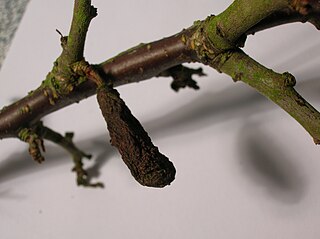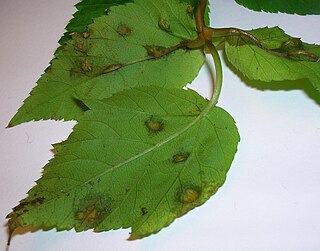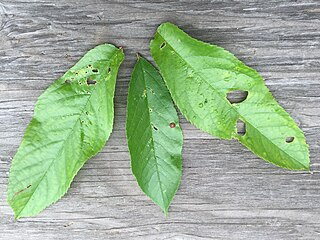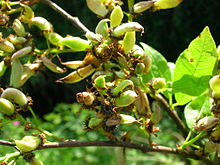
Prunus padus, known as bird cherry, hackberry, hagberry, or Mayday tree, is a flowering plant in the rose family. It is a species of cherry, a deciduous small tree or large shrub up to 16 metres (52 ft) tall. It is the type species of the subgenus Padus, which have flowers in racemes. It is native to northern Europe and northern and northeast Asia, and is grown as an ornamental in North America.

Peach leaf curl is a plant disease characterized by distortion and coloration of leaves and is caused by the fungus Taphrina deformans, which infects peach, nectarine, and almond trees. T. deformans is found in the United States, Europe, Asia, Africa, Australia, and New Zealand. Peach leaf curl reduces the amount of leaves and fruit produced by peach and nectarine trees.

Monilinia fructicola is a species of fungus in the order Helotiales. A plant pathogen, it is the causal agent of brown rot of stone fruits.

Taphrina is a fungal genus within the Ascomycota that causes leaf and catkin curl diseases and witch's brooms of certain flowering plants. One of the more commonly observed species causes peach leaf curl. Taphrina typically grow as yeasts during one phase of their life cycles, then infect plant tissues in which typical hyphae are formed, and ultimately they form a naked layer of asci on the deformed, often brightly pigmented surfaces of their hosts. No discrete fruit body is formed outside of the gall-like or blister-like tissues of the hosts. The asci form a layer lacking paraphyses, and they lack croziers. The ascospores frequently bud into multiple yeast cells within the asci. Phylogenetically, Taphrina is a member of a basal group within the Ascomycota, and type genus for the subphylum Taphrinomycotina, the class Taphrinomycetes, and order Taphrinales.

Gymnosporangium juniperi-virginianae is a plant pathogen that causes cedar-apple rust. In virtually any location where apples or crabapples (Malus) and eastern red cedar coexist, cedar apple rust can be a destructive or disfiguring disease on both the apples and cedars. Apples, crabapples, and eastern red cedar are the most common hosts for this disease. Similar diseases can be found on quince and hawthorn and many species of juniper can substitute for the eastern red cedars.

Monilinia laxa is a plant pathogen that is the causal agent of brown rot of stone fruits.

Podosphaera leucotricha is a plant pathogen that can cause powdery mildew of apples and pears.

Taphrina deformans is a fungus and plant pathogen, and a causal agent[s] of peach leaf curl. Peach trees infected with T. deformans will experience leaf puckering and distortion, acquiring a characteristic downward and inward curl. Leaves will also undergo chlorosis, turning a pale green or yellow, and later show a red or purple tint. Fruit can either drop prematurely or show surface distortions. Severe infection can also produce lesions on the flowers. The host tree will experience defoliation if the leaves are badly diseased. If a seedling is severely infected, it may die. Almond trees display similar symptoms.

Dibotryon morbosum or Apiosporina morbosa is a plant pathogen, which is the causal agent of black knot. It affects members of the Prunus genus such as; cherry, plum, apricot, and chokecherry trees in North America. The disease produces rough, black growths that encircle and kill the infested parts, and provide habitat for insects.

Andricus foecundatrix is a parthenogenetic gall wasp which lays a single egg within a leaf bud, using its ovipositor, to produce a gall known as an oak artichoke gall, oak hop gall, larch-cone gall or hop strobile The gall develops as a chemically induced distortion of leaf axillary or terminal buds on pedunculate oak or sessile oak trees. The larva lives inside a smaller hard casing inside the artichoke and this is released in autumn. The asexual wasp emerges in spring and lays her eggs in the oak catkins. These develop into small oval galls which produce the sexual generation of wasps. A yew artichoke gall caused by the fly Taxomyia taxi also exists, but is unrelated to the oak-borne species. Previous names or synonyms for the species A. fecundator are A. fecundatrix, A. pilosus, A. foecundatrix, A. gemmarum, A. gemmae, A. gemmaequercus, A. gemmaecinaraeformis and A. quercusgemmae.

Taphrina alni is a fungal plant pathogen that causes alder tongue gall, a chemically induced distortion of female alder catkins.

Taphrina pruni is a fungal plant pathogen of blackthorn that causes the pocket or bladder plum gall, a chemically induced distortion of the fruit (sloes), producing swollen on one side, otherwise deformed and flattened fruit gall without a stone. The twigs on infected plants may also be deformed with small strap-shaped leaves.

Protomyces macrosporus is an ascomycete fungus that forms galls on Aegopodium podagraria, Anthriscus sylvestris, Angelica sylvestris, Daucus carota and some other members of the family Umbelliferae or Apiaceae, commonly known as umbellifers. Fourteen genera within the Asteraceae are also galled by P. macrosporus. The description of the genus was based on Protomyces macrosporus as the type genus for the family Protomycetaceae.

Dasineura crataegi, the hawthorn button-top gall-midge, is a dipteran gall-midge. It causes the hawthorn button-top gall, which develops in the terminal shoots of common hawthorn, Crataegus monogyna Jacq., Midland hawthorn C laevigata (Poir.) DC and their hybrid, C × media Bechst. Synonyms are Perrisia crataegi and Cecidomyia crataegi.

The pineapple gall adelgid is a species of conifer-feeding insect that forms pineapple-shaped plant galls on its host species, commonly Norway and Sitka spruce. The adelgids are pear-shaped, soft-bodied green insects with long antennae, closely related to the aphid. Adelges lays up to one hundred eggs at a time, one on each needle. Adelges abietis is one of the most common species; synonyms are A. gallarum-abietis, Chermes abietis and Sacciphantes abietis.

Taphrina wiesneri is a plant pathogen causing witch's broom, or plant gall formations, on cherry trees. It is an important pest species of the ornamental cherry Cerasus X yedoensis in Japan.

Phyllocoptes eupadi is a mite that chemically induces a pouch gall to develop as a sub-spherical distortion rising up from the upper surface of the lamina of leaves of blackthorn shrubs Prunus padus, Prunus spinosa and other Prunus species. Synonyms are Phytoptus padi Nalepa, 1890 and "Eriophyes padi ", non Eriophyes padi Domes, 2000.

Shot hole disease is a serious fungal disease that creates BB-sized holes in leaves, rough areas on fruit, and concentric lesions on branches. The pathogen that causes shot hole disease is Wilsonomyces carpophilus.
Prunus cornuta, the Himalayan bird cherry, is a species of bird cherry native to the foothills of the Himalayas, including China and the countries of the Indian subcontinent. A medium-sized tree, it can reach 18 m. It is used for a rootstock for sweet cherries in India. Its specific epithet references the "horned" deformation of the fruit seen when a tree is afflicted with the fungal disease pocket plum gall, ascribed to the species Taphrina padi.

Taphrina betulina is a fungal plant pathogen that causes the gall, witches broom, which is a chemical infection of birch buds or the developing shoots, leading to a proliferation of growth. It was first described by Emil Rostrup in 1883 and is found in Europe, New Zealand and North America.
























